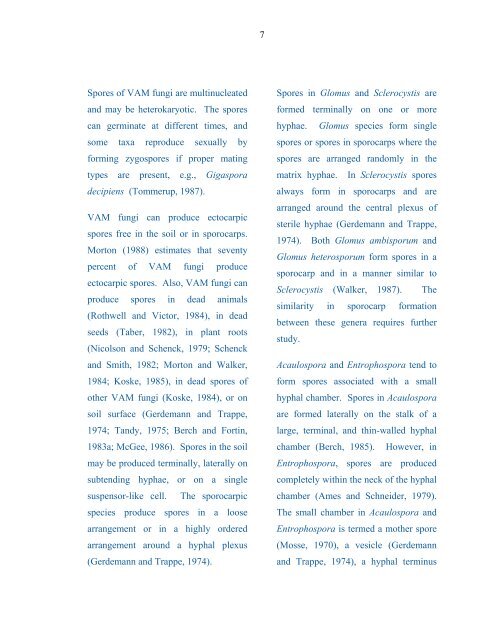Taxonomy and Ecology Of Inland Sand Dune ... - Mycorrhizae
Taxonomy and Ecology Of Inland Sand Dune ... - Mycorrhizae
Taxonomy and Ecology Of Inland Sand Dune ... - Mycorrhizae
You also want an ePaper? Increase the reach of your titles
YUMPU automatically turns print PDFs into web optimized ePapers that Google loves.
7Spores of VAM fungi are multinucleated<strong>and</strong> may be heterokaryotic. The sporescan germinate at different times, <strong>and</strong>some taxa reproduce sexually byforming zygospores if proper matingtypes are present, e.g., Gigasporadecipiens (Tommerup, 1987).VAM fungi can produce ectocarpicspores free in the soil or in sporocarps.Morton (1988) estimates that seventypercent of VAM fungi produceectocarpic spores. Also, VAM fungi canproduce spores in dead animals(Rothwell <strong>and</strong> Victor, 1984), in deadseeds (Taber, 1982), in plant roots(Nicolson <strong>and</strong> Schenck, 1979; Schenck<strong>and</strong> Smith, 1982; Morton <strong>and</strong> Walker,1984; Koske, 1985), in dead spores ofother VAM fungi (Koske, 1984), or onsoil surface (Gerdemann <strong>and</strong> Trappe,1974; T<strong>and</strong>y, 1975; Berch <strong>and</strong> Fortin,1983a; McGee, 1986). Spores in the soilmay be produced terminally, laterally onsubtending hyphae, or on a singlesuspensor-like cell. The sporocarpicspecies produce spores in a loosearrangement or in a highly orderedarrangement around a hyphal plexus(Gerdemann <strong>and</strong> Trappe, 1974).Spores in Glomus <strong>and</strong> Sclerocystis areformed terminally on one or morehyphae. Glomus species form singlespores or spores in sporocarps where thespores are arranged r<strong>and</strong>omly in thematrix hyphae. In Sclerocystis sporesalways form in sporocarps <strong>and</strong> arearranged around the central plexus ofsterile hyphae (Gerdemann <strong>and</strong> Trappe,1974). Both Glomus ambisporum <strong>and</strong>Glomus heterosporum form spores in asporocarp <strong>and</strong> in a manner similar toSclerocystis (Walker, 1987). Thesimilarity in sporocarp formationbetween these genera requires furtherstudy.Acaulospora <strong>and</strong> Entrophospora tend toform spores associated with a smallhyphal chamber. Spores in Acaulosporaare formed laterally on the stalk of alarge, terminal, <strong>and</strong> thin-walled hyphalchamber (Berch, 1985). However, inEntrophospora, spores are producedcompletely within the neck of the hyphalchamber (Ames <strong>and</strong> Schneider, 1979).The small chamber in Acaulospora <strong>and</strong>Entrophospora is termed a mother spore(Mosse, 1970), a vesicle (Gerdemann<strong>and</strong> Trappe, 1974), a hyphal terminus


